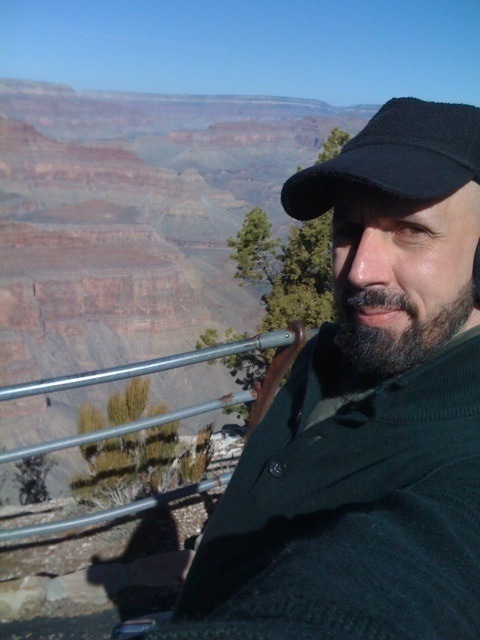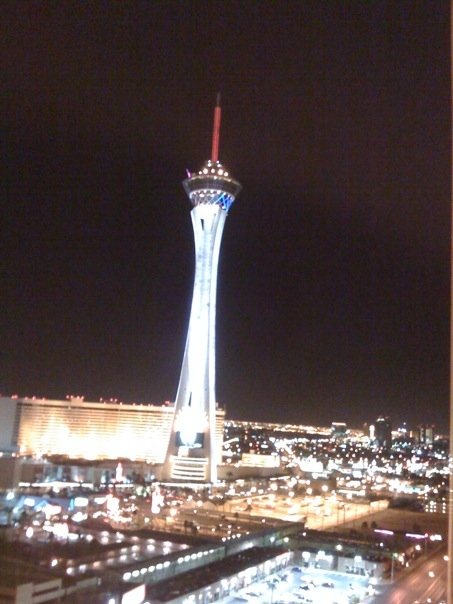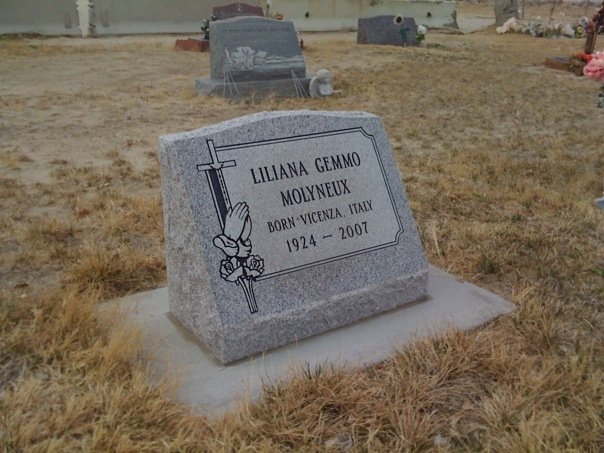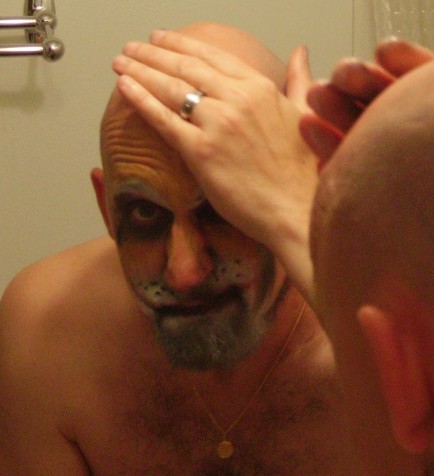A Little Pick-Me-Up
Mood:
 happy
Topic: Makin' Movies
happy
Topic: Makin' Movies
It's seven weeks to the day from when team Fogbelt 2880 hit Golden Gate Park to shoot "How the Bunny Got the Bear".
During that long shooting day circumstances forced me to drop several short scenes and shots that, while fun and funny, weren't necessary to get the main story points across. However, I always regretted losing some of that material, because it was fun stuff, and its absence changed the story balance slightly because the son bunny Gus's original introduction was lost, and it makes him a smaller part of the story overall.
Well, today's my chance to try to make up for that, as some key members of Fogbelt 2880 reassemble to do pickup shots that will allow the film to be completed more as it was originally intended.
I tried REALLY hard to be prepared in a way that was not possible for the 48 Hour Film Project. I had written a custom script of just the material we’re going to shoot. I had storyboarded some of the shots I wanted. I'd made a fairly comprehensive shot list. I'd captured frames from the original footage and printed out sheets of these for continuity purposes. I had sent checklists to the crew of what everyone should bring (the costumes, for instance, were all over the place... ears here, tails there, shirts elsewhere), and asked Tim if his camera has a composite video out I could plug a small LCD monitor into. I'd even printed maps to show where all the potential locations were and how to get from my place to them.
Furthermore, I had spent three hours yesterday biking around the west half of Golden Gate Park scouting locations that we could use. I had my digital camera with me to shoot reference photos and a map of the Park on which I could mark said locations.
- I was looking for a place the parent rabbits could bolt into the bushes. I found some perfect shrubs near a playground.
- More important, I needed something that could serve as the "door" to the home of the rabbits. I noted four possible places where trees or paths made what could pass as a sort of figurative entrance. This was the main location we needed, because two scenes take place there. I found several possible spots for this, two near our original location, and one a short drive away. I knew where I really wanted to shoot it, but when I'd driven by it a few days earlier, there was grounds work going on around it.
- I figured we'd return to our original location for Gus's introduction and to shoot a new set of lines of the parents to set up a new "PTA" joke.
- Finally, we'd need a place to shoot the PTA joke itself. I knew we could shoot that almost anywhere, but, if time permitted, I found a beautiful spot next to the lodge building by the park's fly fishing ponds.
The crew was to assemble at my place by 7:30, but I start getting phone calls before 7. One Becky calls to say Jim was getting the clothes together that he and John had worn, but he can't remember who had worn which pants, so I have to review the film in hi-def to study their behinds and say who had worn pants with back pockets with flaps and who hadn't. Then "Beckster" Becky (in team vernacular) calls to say she only had one of the bunny tails, not both as she'd thought, etc.
Our crew for the day are actors P.A., Jim, and John, and behind the camera the two Beckys, cameraman Tim, sound guy Will, and Erik "Mother Nature" Braa, and myself. Roles are fluid because it's a small crew and we'll all have to pinch hit, but mostly the actors act, Will listens, Beckster booms, Becky slates, Tim shoots, I direct, and Erik does anything else we need.
Everyone but Erik is at my house on time, and P.A. shows up already made up, as he has a limited availability and needs to be done by 11 a.m. We saddle up and head for the first location.
As above, I'd located seveal possible "door" locations the day before, but as I was heading home, I'd decided to bike by my first choice for the location...and the grounds keeping equipment was gone! I told the crew this is where we'd try to start. We all head to this location, and will move to an alternate only if it's unworkable. That location is Lloyd Lake and the Portals of the Past. The Portals is what was once the portico of the mansion of A.N. Towne, and was all that remained standing of the home after the 1906 earthquake. It was moved to Lloyd Lake as a symbol of the perseverance of San Francisco. (Click here to see the house that once bore this entrance, and here to see the portico standing in the aftermath of the earthquake with ruined City hall in the distance.)
We find parking and decide to go for it. We hurriedly get our gear unpacked and head around the small lake to the Portals. I love the idea of this as a location, for, as the "interior" of the Finkelstein (rabbit) family home is outdoors, the Portals are perfect as they are essentially a gateway to nothing.
There are obstacles I knew of going in: there's a concert going on in Speedway Meadow--smack between our two main locations--and there's the weather. The summer fog petered out last week, and it's been clear skies. At Lloyd Lake the sun's shining and there's already lots of cars parking along the road. I hope we can get in and out before it becomes unusable. The bright light could be a problem, but since this scene is "outside" the house I figure we can live with it being somewhat brighter than the later "inside" scenes... and, heck, if that doesn't work I'll be spending a lot of time in post adjusting the video.
While Jim and John get made up we start shooting P.A. as Gus in the scene where he answers the door to find an off-camera visitor and reacts in surprise. I coached P.A. on what I wanted him to do, telling him come out from the pillars in a skip-hop fashion and to do a little nose twitching that would match what his parents did in the original shoot. We first do the take from a wide angle where you can see the entire structure and that it isn't connected to anything, and after that, we move closer and change the angle slightly to focus on him. I’d written one line for this, but tell P.A. to just play with it and he delivers something different almost every take. Fun fun! By this point Erik has found his way to us, shorn of beard he looks less dazzling than Mother Nature... or something...
Two technical problems provide my only real vexations for the day. First, Tim was wrong about his camera... there is a composite signal out, but he doesn't have the right connector, so again I can't use a monitor, despite the fact I have one with me! Second, Will points out that the sound we're getting is likely not going to be entirely useable because there's a nearby sprinkler which he can hear clearly over the headphones, and there's noise from the concert setup across the way. I reply we'll just have to plan to loop the dialog later in Matt's studio, as we don't have the luxury of coming back another time, and what we record here is what the actor's will listen to and match when looping.
With P.A.'s scene done we shift to the parents arriving home. Jim and John's asses are the subject of much discussion as we try to get their tails to match the previous shoot. As with P.A., we first shoot wide as they tiredly skip-hop to their mark and run their dialog, then tip-toe into the portico when they hear off camera noises. After getting it wide, we go closer for a medium two-shot and do it a bunch more times. With all that done we're almost ready to move out. I send Will and Beckster and Erik and P.A. to start loading up the cars, while Becky, Tim and I hurry over to a point across the water from the Portals, from which we shoot a wide establishing shot of the location with Jim and John arriving, reflected in the water. Pretty!
My goal was to be fiished by noon, and I need to get P.A. done even sooner, so we need to get a move on. We drive over to Metson Lake where we'll shoot P.A.'s only other scene. The trouble is, the concert stuff is starting and the noise is a problem. We're definitely going to have to loop.
I'd originally planned to shoot at the same log where Gus and Gloria are discovered by the parents, but that's now impossible because the parks people moved said log over 20 feet, and its previous spot is in directly sunlight, which wouldn't match what we'd shot previously. I pick a different log that's in some shade and someone smartly points out that Gus could be in a different "room" in the "house" in this scene; they're right...no one's going to notice. This was the most important scene I had to get, because it's P.A.'s "entrance", and where his character gets established (in the film, it'll appear just before the scene of P.A. we shot at the Portals). I had carefully storyboarded this, so I knew exactly what I wanted. I coach P.A. on his action. I want him to lean on the log like a teenager with his schoolbook propped up on a sofa back. He's to hold his book in front of him, so at first we just see the bunny ears above the book covers, then lower the book to for his reveal, and deliver his dialog. He then needs to toss the book aside, then react of a "doorbell" and exit in frustration.
About the book: I'd spent the equivalent of one entire day getting the prop ready for this shot. Originally I'd planned to have a book titled "How to Multiply" that looked just like the one Bugs Bunny is reading in the cartoon “Easter Yeggs,” but then I'd hit on the idea of making the book a parody of one of those "For Dummies" books. I spent many hours laying out and then printing and assembling a book titled "Multiplication for Bunnies" in the "Dummies" style. The cover was printed on shiny card stock and looks just like a printed book, with in jokes and twists on "Dummies" slogans all over it that you'll never be able to read on screen, but which the crew found hilarious. Also, I'd designed two custom pages for the book interior, featuring two improbable bunny style "additive multiplication" problems.
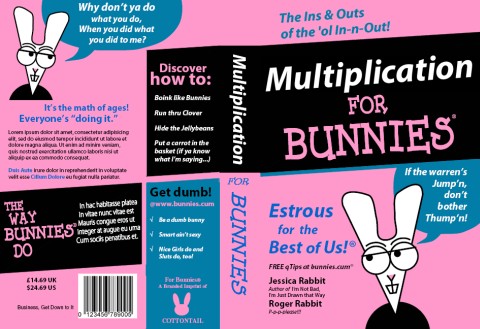
To make sure the book was functional as a prop and would not cause us any shooting delays, I'd constructed it in such a way that it was relatively foolproof. I'd taken a trade paperback and used heavy duty adhesive to adhere the new cover over the actual cover (and had two backup covers printed in case one got damaged). I spray glued the custom pages into the book near the middle. Then, to make sure the book always opened to the same spot, I'd poured white glue onto the bottom of the book near the spine, then prssed in into the page edges and wiped it off the surface. I then put a plastic bag between the two custom pages to keep them from getting stuck together, then closed the book and put weight on it while the glue dried. The result is that the pages still flip (sorta), but if you drop the book on the ground on its spine it always opens to the custom pages. Sometimes I be smart!
We got the shots of P.A. relatively quickly. The camera starts tight on the book cover, then zooms out just enough to see the ears and the top of the log, P.A. lowers it and does his shtick. Since we had to do multiple takes, and as such it's not a good idea to let the book get damaged, I asked Jim to try to catch the book each time P.A. threw it off camera. Jim said "you've got the wrong guy", but, despite his worries, he caught it one every take.
Finally, we hurried to another log to shoot a reverse over P.A.'s shoulder so we can see the improbable math problems that are vexing him. With those done, we wrap P.A. and send him on his way. Thanks P.A.!
Next, Tim and I find a spot to shoot an insert of the book landing after Gus tosses it. We shoot a number of these, me dropping the book on the ground, always landing open to the correct pages. These shots are my safety, because with it and the over the shoulder, I have two options for showing the Math problems, and I can use whichever works best in the film rather than being stuck with only one option.
The sun's climbing and it's getting hotter, and shade of any sort is becoming a scarce commodity. As it is, we have all the important stuff needed to finish the film's opening correctly, but there's still the new gag I want to get in.
This gag was not in the original script, but was inspired by a line John improvised in the sound booth, where he said, "What are you thinking?! What will my PTA think?" I loved that line, and it gave me an idea for a sight gag. The trouble was, when I reviewed the footage we'd shot previously there was no good spot where I could just shoehorn the line in. But I knew roughly where in the scene I wanted it, so I decided to do a retake of one small part of the family discussion.
It went like this...
GLORIA: We're going to be married.
HARVEY: Over my tanned pelt! Look what you've done!
(as Jessi does her "I'm a comin' Jesus" moment)
GUS: What's the big deal?
But I want it to be this... GLORIA: We're going to be married.
HARVEY: Over my tanned pelt! Look what you've done!
(Jessi does her "I'm a comin' Jesus" moment)
JESSI: (to Gus) What are you thinking? (to Harvey) What will my PTA think?
Again, the sun's making it difficult as the place where we'd originally shot this material is in direct sun and won't match no way no how. So, we move the actors to a spot in the shade about 50 feet away, in front of the pussy willows that were at the very edge of the frame in some of the existing footage. I had Tim shoot from farther to their left than we had previously, hoping that this new angle will hide the fact that we aren't in exactly the same spot. But, to ensure the action matches and increase the chances it'll cut together neatly, I'd printed screen captures of Jim and John during that sequence, and when we get them set up, we review the scene as it exists now on my laptop, so the actors can see exactly how they'd been sitting and what the action was. With Erik sitting-in as a Gloria stand-in and delivering her line, we shoot it. Jim and John are hilarious as always. I hope it works!
There were two other bits I'd hoped to shoot with Jim and John, but they would have required moving to a third location because nothing was workable where we were, but I feel that stuff, while fun, isn't really necessary, and decide to let it go. Jim and John are wrapped!
This leaves only one thing left to shoot: The PTA gag.
This one's just a sight gag that occurred to me on hearing John's PTA ad lib. I imagined a cut to a PTA meeting where the little forest animals react to the news that Gus is marrying a bear. I imagined blank, shocked stares of these characters, holding teacups, and one of them drops the cup. Then we cut back to the action.
To accomplish it, I basically cannibalized the crew except for Tim. Both Beckys, Will, Erik and I are made up and don animal ears (I'd bought some ears for different animals, so we had three other animals and two rabbits). I brought a set of four dainty little flower-patterned espresso cups my mama had given me, and my fellow PTA members hold those as I hold THE book, as if we are discussing coursework. We sit in a tight semicircle.
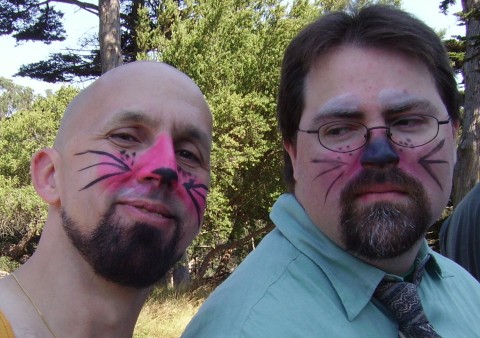
But is Jim in or out of character?
John directs, deciding that we should all start out laughing at something, then turn as if we're hearing someone tell us some news, and then react in horror to the news, at which point teacups fall. Our cues are: "Laugh. Spot. Shock. Drop!" After a few takes it's obvious that something isn't working because we all have to look at a spot directly below the camera, but going from the laugh to finding this spot with your eyes isn't instant, and I have a particularly hard time because I am seated somewhat in profile and have to turn my head. Jim takes to shaking a small water bottle, and the movement allows you to look at the spot on cue. We do several takes with everyone dropping their cups, and then just Will dropping his.
Then, with many teacup drops completed, we wrapped the shoot. Hooray!
As it turns out, I realize we missed one shot on my list, but it's so unimportant that I decide it's not worth bothering with.
I'd promised to but lunch for everyone, but Jim and Becky head home, and Tim gets lost and never makes it. The rest of us went to Tommy's for food and celebratory drinks. Erik quickly wiped off his makeup, but the rest of us went as we were... ears and all. We got many bunny looks, but that's another story...
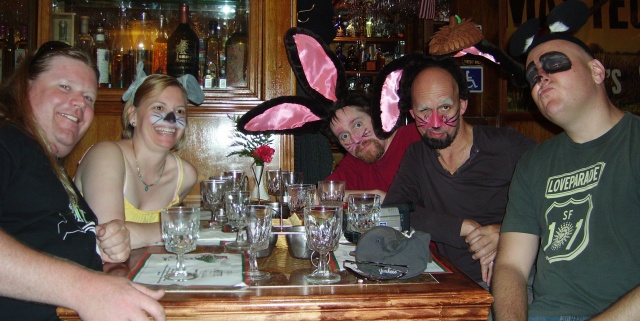
The Fogbelt Fables PTA meets with Mother Nature's lesser known younger Brother Nature to discuss the shocking news of the day.
Posted by molyneaux
at 12:01 AM PDT
Updated: Monday, 8 September 2008 1:13 AM PDT

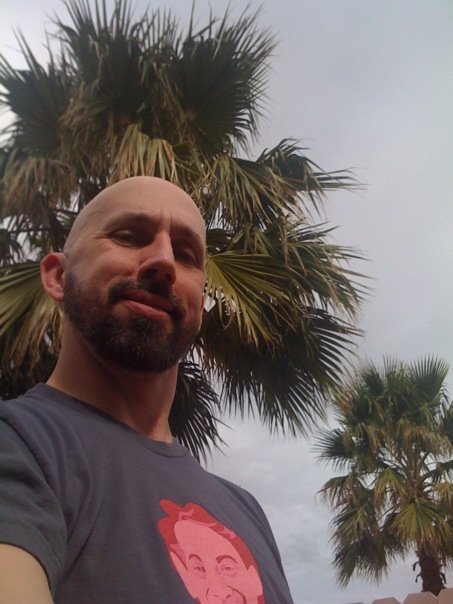
 .
.



